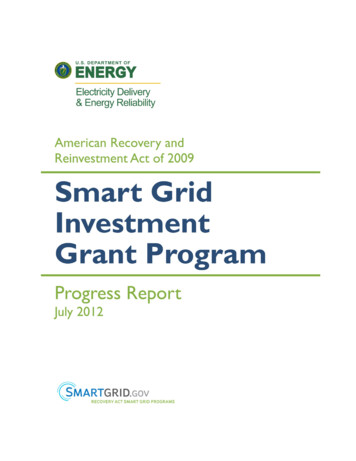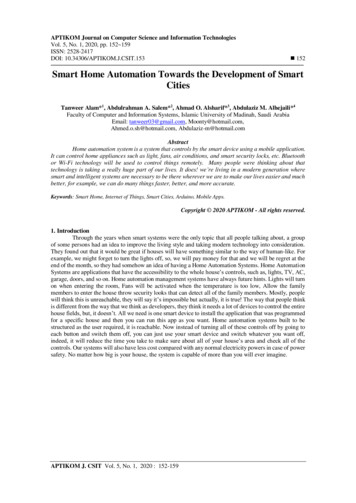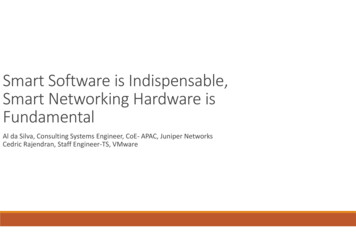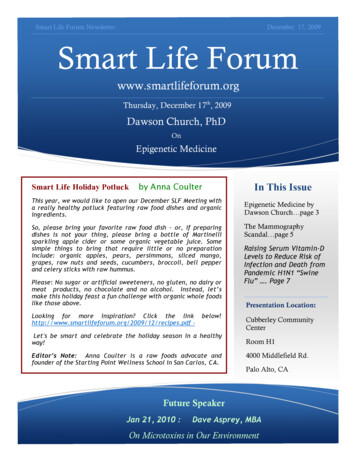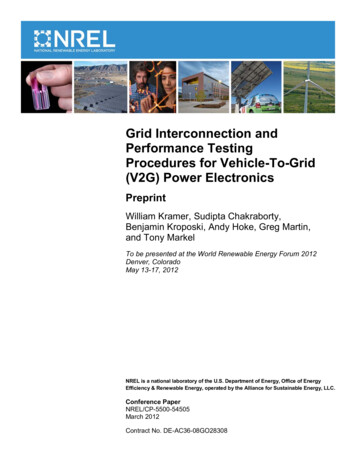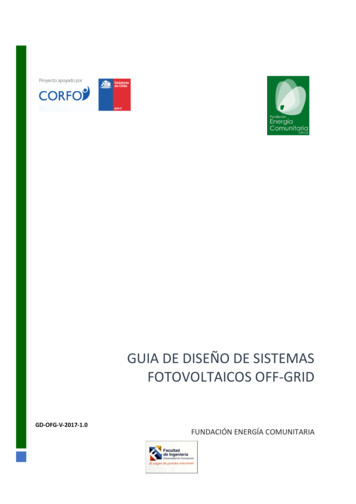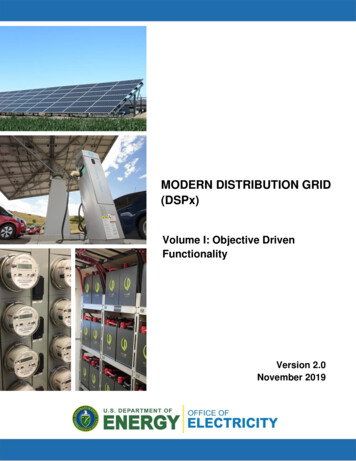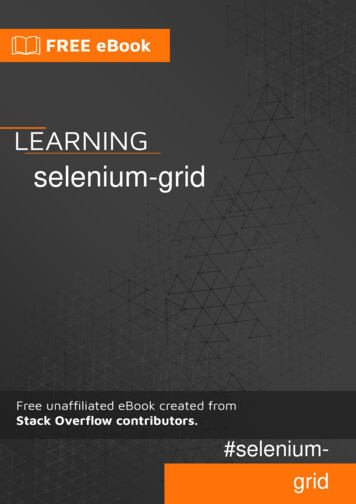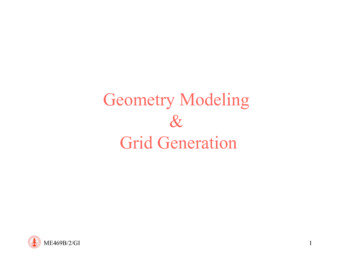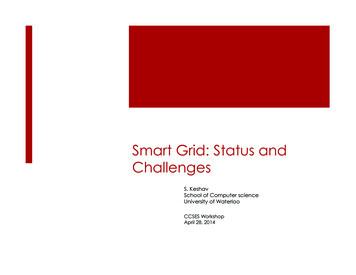
Transcription
Smart Grid: Status andChallengesS. KeshavSchool of Computer scienceUniversity of WaterlooCCSES WorkshopApril 28, 2014
Outline¡ The grid has real problems¡ that smart grids can solve¡ These problems are intrinsic and difficult¡ so progress has been slow¡ Three areas where changes are imminent aresolar, storage, and sensing¡ I’ll give some examples of my work in these areas
The grid has some real problems
41. Overprovisionedcapacity
2. Inefficient5% better efficiency of US grid zero emission from 53 million carshttp://www.oe.energy.gov/
3. AgingPost-war infrastructure isreaching EOL
4. UnevenTWh generatedDaily W/capita (2012 est.)¡ China4,938395¡ US4,2561402Wikipedia
5. Poorly measured
6. Poorly controlled¡ Electrons are not addressible
7. Huge carbon footprint
Smart grid vision
Current grid“Smart” gridHigh carbon footprint ¡ Renewables/low carbonLittle to no storage ¡ Storage richPoorly measured ¡ Sensing richPoorly controlled ¡ Control richOssified ¡ FlexibleInefficient ¡ Energy frugalCentralized generation ¡ Decentralized generation
Source: European technology platform: Smart Grids
Intrinsic challenges
1. Matching demand and supply'SPN #BSOIBSU FU BM 1SPD &OFSHZ BOE &OWJSPO 4DJ 7 QQ Barnhart et al, Proc. Energy and Environment, 6:2804, 2013
2. Controlling distributed generatorsUS EIA
3. Control over many time scalesJeff Taft, Cisco
4. Complex control architectureReference ModelTrans-Regional Balancing Org.Synchronous Grid Inter-Tie ControlTrans-Regional Energy MarketsTrans-Regional NetworksWide Area Monitoring and Control System (WAMCS) NetworksInterchange Authority/Reliability CoordinatorGrid Direct Current (DC) Inter-TiesBalancing AuthorityOther Region PhasorMeasurement Unit(PMU) DataInterchange TierOther Balancing AuthoritiesArea ControlError (ACE)ControlVirtual Power Plant (VPP)/Demand Response (DR)ApplicationOther Energy TradersVPP/DRApplicationACEControlControl Area NetworksUtility EnergyTradingConventionalWindSolar Customers Suppliers Retail EnergyProviders (REP) Third PartiesOther TransmissionSystem Operators (TSO)/Distribution SystemOperators (DSO) and VerticalsEnterprise NetworksData CenterEnterpriseApplicationsand UsersData CenterNetworkCallCenterControl CenterApplicationsand UsersControl CenterControl CenterFieldDispatchControl CenterNetworkIntra-Substation NetworksPhasorMeasurementUnit (PMU)DistributionSubstationIntra-Substation NetworksSystem Control tributionPMUIntra-Substation NetworksSubstation TierIntra-Substation NetworksDistribution LevelStabilizationSensor NetworksTransmission LevelStabilizationIntra-Control/Data Center TierControl CenterNetworkInter-Substation ucers(IPP)Utility TierInter-Control Center NetworksTransmission PMU DataTractionSubstationBalancing TierStorageThird PartyStabilizationServicesWeb PortalsUtilityNOCOther RegionsInterchange NetworksWAMCS NetworkOperations Center (NOC)/Data CenterOther TSOPMU DataTrans-Regional/Trans-National TierWholesale Energy MarketsVPP/DR Data/SignalsSensor Networks(DSTATCOM)Urban FANsRural FANsNeighborhood Area Networks (NAN)(Residential, Commercial and Industrial)D Level 1 TierDistribution Automation (DA)Sub-networksStreetlight SystemsElectric Vehicle (EV)Sub-networksConverged Voice,Data, and VideoThird Party Aggregatorof DR, DistributedGeneration (DG), etc.Volt/ VAR RegulationDA DevicesD Level 2 TierFault Isolation and ServiceRestoration NetsSensor SubsystemsLine SensorDistributedDistribute EnergyResourc (DER)Resources(large scale)InternetFeederD-PMUNetsGatewayResidential NetworksHome Energy ControllerControlsBuilding NetworksInverter ControlInDER ProtectionDPrivate Microgrid NetworksSensorsProtection and ControlControlsInverter ControlIn-Vehicle NetworksProsumer TierChargerMeterInverter ControlDisplays 2011 Cisco and the Cisco Logo are trademarks of Cisco and/or its affiliates in the U.S. and other countries. A listing of Cisco’s trademarks can be found at www.cisco.com/go/trademarks. Third-party trademarks mentioned are the property of their respective owners. The use of the word partner does not imply apartnership relationship between Cisco and any other company. (1009R)C82-676734 6/11Cisco
5. Consumers lack incentives¡ Energy savings of 10%¡ 10/month
6. Utilities also lack incentives!
7. Huge legacy infrastructure
8. Storage is complex and expensive¡ No clear winner in terms of technology¡ Need to balance energy and power
Status
Depressing A. Demand response – only time of use pricingB. Storage - tinyC. Smart buildings and homes – demo stageD. Microgrids – rareE. Electric vehicles – early stageF.Security and privacy – mostly missing
Three inflection points¡ Solar¡ Storage¡ Sensing
McKinsey, 2014
Storage¡ Global investment to reach 122 Billion by 2021Pike Research
Storage alternatives“Bytes”“Bits/s”Declining to 125/KWh
Process storage
Thermal storage
SensingMichigan Micro Mote
So what?
GridInternetSolar Variable bit-rate sourceElectrons BitsStorage BufferTransmission line Communication linkTransmission network Tier 1 ISPDistribution network Tier 2/3 ISPDemand response Congestion control
Equivalence Server(C)LnEvery trajectory on the LHS has an equivalent on the RHS can use teletraffic theory to study transformer sizingO. Ardakanian, S. Keshav, and C. Rosenberg. On the Use of Teletraffic Theory in Power Distribution Systems, e-Energy ’12.
Guidelines for transformer sizingHydroOne’s guidelinesPrediction from teletraffic theoryCan also quantify impact of storageO. Ardakanian, S. Keshav, and C. Rosenberg. On the Use of Teletraffic Theory in Power Distribution Systems, e-Energy ’12.
rical%Vehicle%Charging%“TCP”for EV chargingSmart%Grid%Architecture%%¡ 1 EV 5 homes¡ Creates hotspots¡ Real-time AIMD control ofEV charging rate¡ Solution is both fair andefficient4%O. Ardakanian, C. Rosenberg and, S. Keshav, “Distributed Control of Electric Vehicle Charging”. e-Energy ’13
Stochastic network calculusJoint work with Y. Ghiassi-Farrokhfal and C. Rosenberg
“Rainbarrel” modeluncontrolledstochastic inputrangeWhat barrel size to avoidoverflow and underflow“with high probability”?uncontrolledstochastic output
Envelope idealower envelope Σinput upper envelopeEnvelopes are computed froma dataset of trajectorieslower envelope Σ output upper envelope
Stochastic envelopesP((Σinput - lower envelope) x) ae-xP((upper envelope –Σinput) x) be-x
Stochastic network calculusEquivalenceWang, Kai, et al. "A stochastic power network calculus for integrating renewable energy sources into the power grid.”Selected Areas in Communications, IEEE Journal on 30.6 (2012): 1037-1048.
Analytic results¡ Minimizing storage size to smooth solar/wind sources¡ Optimal participation of a solar farm in day-aheadenergy markets¡ Modeling of imperfect storage devices¡ Optimal operation of diesel generators to deal withpower cuts in developing countriesJoint work with Y. Ghiassi-Farrokhfal, S. Singla, and C. Rosenberg
Load reduction using extreme sensing
Smart Personal Thermal ComfortFine-grained thermal control of individual officesP.X. Gao and S. Keshav, Optimal Personal Comfort Management Using SPOT , Proc. BuildSys Workshop, November 2013.P. X. Gao and S. Keshav, SPOT: A Smart Personalized Office Thermal Control System, Proc. ACM e-Energy 2013, May 2013.
Our insight
In a nutshell¡ Mathematical comfort model¡ When occupied, reduce comfort to the minimum acceptablelevel¡ When vacant, turn heating off¡ Optimal model-predictivecontrolTemperature¡ Pre-heat26252423222120Occupancy6 7 8 9 10 11 12 13 14 15 16 17 18Time of a day
Extreme sensing5 infraredsensorServos90 infraredsensorMicrosoft KinectMicrocontrollerWeatherduck sensor
Comparision of schemesAverage Daily Energy (kWh)25FixedScheduledReactive TempReactive PPVOptimal201510500.40.50.60.7Average Absolute PPVDiscomfort0.80.9
Reflections on the research area
Energy researchPros¡ Rapidly growing area¡ Many open problems¡ Industry interest and support¡ Motivated students¡ Potential for impactCons¡ Requires learning newconcepts and ideas¡ Entrenched interests¡ Difficult to obtain data¡ Field trials nearly impossible
Many open research problems¡ Renewables integration¡ Multi-level control¡ Non-cash incentive design for consumers¡ Energy efficiency policies for utilities¡ Storage size minimization in energy systems¡ Incentives for EV adoption¡ Data mining of energy data sets¡ Peak load reduction¡ HCI for energy applications¡ Data center energy minimization¡ Microgrid/nanogrid design¡ Building energy use monitoring and reduction
Many publication venuesConferences/workshopsJournals¡ ACM eEnergy¡ IEEE Trans. Smart Grid¡ IEEE SmartGridComm¡ IEEE PES magazine¡ ACM Buildsys¡ Energy and Buildings¡ ACM GreenMetrics¡ J. Solar Power¡ IEEE CCSES¡ J. Power Sources¡ ACM Sustainability¡ Transportation¡ AAAI AAMAS
ACM e-Energy 2014¡ Premier conference at the intersection of Internettechnologies and energy systems¡ Sponsored by ACM SIGCOMM¡ June 11-13, 2014 in Cambridge, UK¡ Early registration deadline is Wednesday!
Conclusions¡ The grid has some real problems¡ Smart grid offers solutions, but it is still earlydays¡ Three areas to watch out for¡ Solar¡ Storage¡ Sensing
Acknowledgements
ISS4ECo-DirectorAffiliated facultyhttp://iss4e.ca
ISS4E students
Our next project
partnership relationship between Cisco and any other company. (1009R) C82-676734 6/11 Distribution Level Stabilization (DSTATCOM) Neighborhood Area Networks (NAN) (Residential, Commercial and Industrial) Residential Networks Building Networks Private Microgrid
